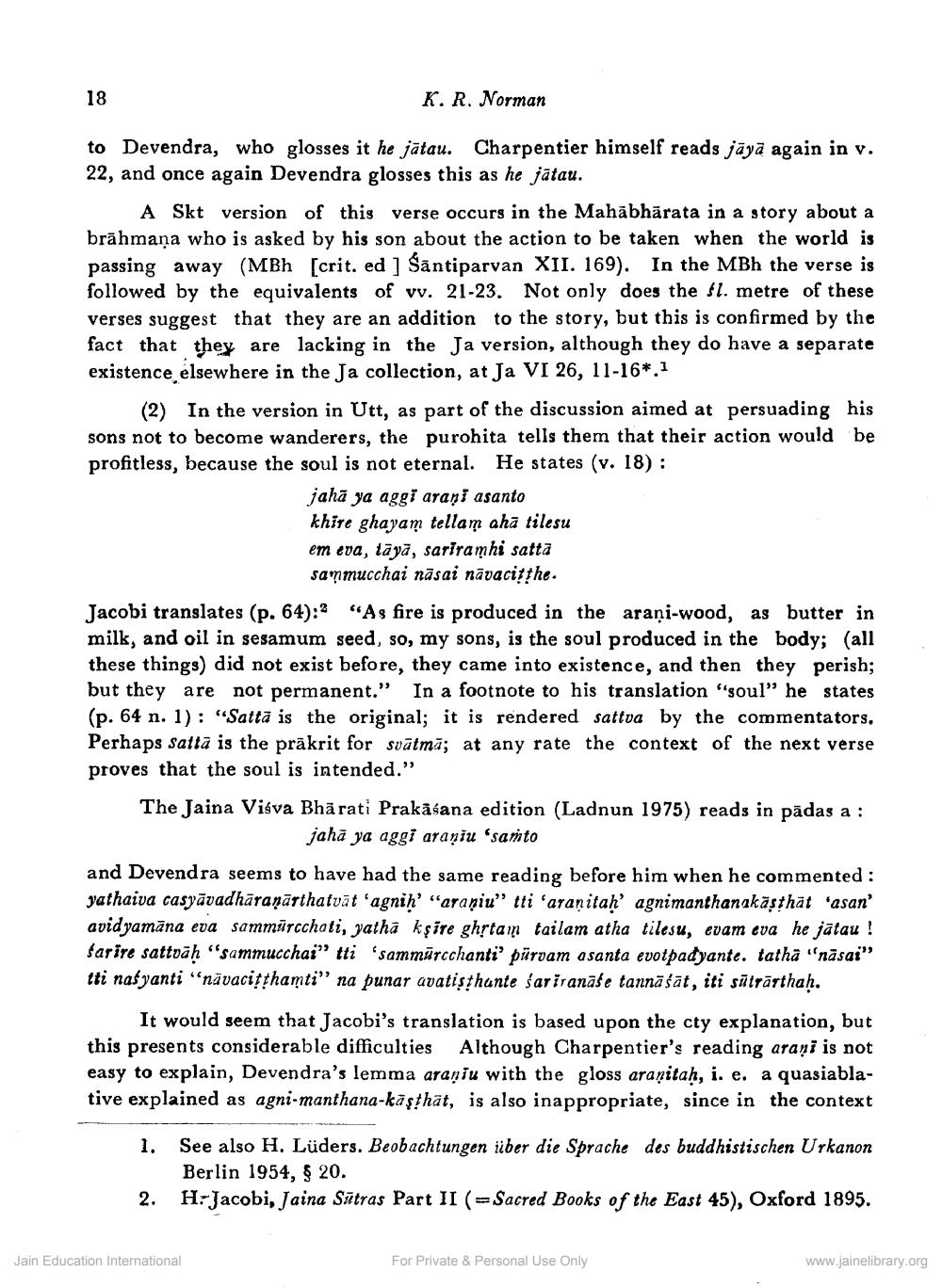Book Title: Uttarajjhayanan Sutra XIV Usuyarjjarah Author(s): K R Norman Publisher: Z_Aspect_of_Jainology_Part_3_Pundit_Dalsukh_Malvaniya_012017.pdf View full book textPage 3
________________ K. R. Norman to Devendra, who glosses it he jātau. Charpentier himself reads jāyā again in v. 22, and once again Devendra glosses this as he jātau. A Skt version of this verse occurs in the Mahābhārata in a story about a brāhmaṇa who is asked by his son about the action to be taken when the world is passing away (MBh [crit. ed ] Santiparvan XII. 169). In the MBh the verse is followed by the equivalents of vv. 21-23. Not only does the Sl. metre of these verses suggest that they are an addition to the story, but this is confirmed by the fact that they are lacking in the Ja version, although they do have a separate existence elsewhere in the Ja collection, at Ja VI 26, 11-16*. 1 (2) In the version in Utt, as part of the discussion aimed at persuading his sons not to become wanderers, the purohita tells them that their action would be profitless, because the soul is not eternal. He states (v. 18): jaha ya aggi arani asanto khire ghayam tellam aha tilesu em eva, tāyā, sariramhi satta sammucchai nāsai nāvacitthe. Jacobi translates (p. 64):2 “As fire is produced in the araņi-wood, as butter in milk, and oil in sesamum seed, so, my sons, is the soul produced in the body; ( these things) did not exist before, they came into existence, and then they perish; but they are not permanent." In a footnote to his translation "soul" he states (p. 64 n. 1): "Satta is the original; it is rendered sattva by the commentators, Perhaps satta is the prākrit for svātmā; at any rate the context of the next verse proves that the soul is intended." The Jaina Visva Bhārati Prakasana edition (Ladnun 1975) reads in pādas a : jaha ya aggi araniu 'santo and Devendra seems to have had the same reading before him when he commented: yathaiva casyāvadhāraṇārthatvāt'agnih' "araniu" tti 'aranitah' agnimanthanakāşthat 'asan' avidyamāna eva sammārcchati, yatha kşire ghrtain tailam atha tilesu, evam eva he jātau ! farire sattväh "sammucchai" tti 'sammūrcchanti' pürvam asanta evotpadyante. tathā "näsai" tti naš yanti "nävacitthamti" na punar avatişthante sariranāse tannāśāt, iti sātrārthaḥ. It would seem that Jacobi's translation is based upon the cty explanation, but this presents considerable difficulties Although Charpentier's reading araņi is not easy to explain, Devendra's lemma araniu with the gloss arañitah, i. e. a quasiablative explained as agni-manthana-kāşthāt, is also inappropriate, since in the context 1. See also H. Lüders. Beobachtungen über die Sprache des buddhistischen Urkanon Berlin 1954, $ 20. 2. H: Jacobi, Jaina Sūtras Part II (=Sacred Books of the East 45), Oxford 1895. Jain Education International For Private & Personal Use Only www.jainelibrary.orgPage Navigation
1 2 3 4 5 6 7 8 9 10 11
